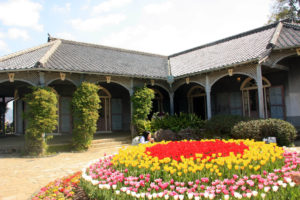Nagasaki UNESCO World Heritage / Industrial Revolution
The origin of Japan’s modernization is here. Under the growing sense of crisis over a foreign
menace, Nagasaki supported the introduction of Western countries technology, which started
during the last years of Japan’s National isolation period. With “ Dejima ” as the only window
to West during the period of National isolation. Nagasaki has contributed to Japan’s modernization
by serving as a place to acquire knowledge from oversea.
Nagasaki contributed for Shipbuilding and Coal Mining and 7 sites have been
registered on the UNESCO World Heritage, Sites of Japan’s Meiji Industrial Revolution.
Located on Minami-Yamate hill in Nagasaki-city, Glover Garden has nine Western style buildings
including the Glover’s Residence built in 1863 by Japanese carpenter Koyama Hidenoshin. The
Glover Residence is Japan’s oldest wooden Western-style building.
Former Pattern Shop / Shipyard History Museum
The Former Pattern Shop was built in 1898 to produce wooden patterns for castings and is the
oldest factory building in the shipyard. It is a two-storied brick building with a timber roof truss.
There is a U-shaped rail on the ceiling to transport materials. The building was refurbished to the
Shipyard History Museum in 1985 and is open to the public.
 |
 |
 |
 |
 |
 |
Giant Cantilever Crane
The Giant Cantilever Crane is the first electric-powered crane of its type in Japan, imported from
Scotland in 1909, which is the oldest surviving one in operation in the world. It can still lift a load
of 150 tons and is used to ship heavy goods.
 |
 |
 |
Hashima Coal Mine / Gunkan-jima island
Hashima coal mining island is an artificial reclaimed island and the site of Japan’s first major
undersea coal exploitation (1890) pioneered by Mitsubishi – and host to one of the world’s
most extraordinary former mining communities. Hashima Island is located 3 km southwest of
Takashima, and it was the success of Takashima that led Mitsubishi to purchase this island – both
islands giving access to the same undersea coal deposit. Now Hashima is a ruin called “Gunkanjima”,
so called after its resemblance to the silhouette of a battleship.
 |
 |
Home Tailor-made tours Study tours Christian Pilgrimage tours Golf tour Kyushu tour packages







